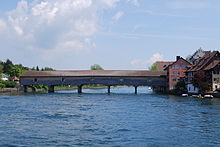List of Rhine bridges 1853

Course of the Rhine Lower Rhine Middle Rhine Upper Rhine Lake Constance , Alpine , Front and Rear Rhine
The list of Rhine bridges in 1853 names bridges which, according to a contemporary source, crossed the Rhine or its estuary in 1853 . The list follows a compilation of the bridges over the Rhine (from Lake Constance on) by Heinrich Meidinger : The German rivers in their traffic and trade conditions, with statistical overviews : Dept. 2: The Rhine, Leipzig: Fleischer 1853, p. 14 -16. The bridges are listed downstream. In 1853 there were only flying bridges , ship bridges and a steam ferry below Basel .
Upper Rhine
- Stein am Rhein, Jochbrücke, Rheinbrücke Stein am Rhein
- Diessenhofen, covered bridge, Rhine bridge Diessenhofen – Gailingen
- Schaffhausen, open wooden bridge on pile yokes, Rhine bridge Schaffhausen – Feuerthalen
- Rheinau, covered bridge, Rheinau-Altenburg bridge
- Eglisau, covered bridge, Rhine bridge Eglisau
- Kaiserstuhl, Rhine bridge Kaiserstuhl – Hohentengen
- Zurzach. Below the place there was 1847-1936 the flying bridge at Kadelburg.
- Laufenburg, Laufen Bridge
- Säckingen. This little town is located on an island and has two bridges, a stone on the Swiss side and a wooden one on the Swabian side, the wooden bridge Bad Säckingen
- Rheinfelden, covered bridge, old Rhine bridge Rheinfelden
- Basel, Middle Bridge
Upper Rhine
- Hüningen, flying bridge
- Alt-Breisach, flying bridge
- Kehl, long ship bridge to Strasbourg. From the large Rhine bridge one comes across an island to the small Rhine bridge and from there to Strasbourg, through the Metzgertor.
- Maximiliansau, ship bridge (formerly to Knielingen). This place is 1¾ hours from Karlsruhe and is to be regarded as the new port of this residence.
- Plittersdorf (Selz), flying bridge
- Germersheim (fortress at the mouth of the Queich), ship bridge. The Germersheim bridgehead, although on the right bank of Baden, still belongs to Bavaria. Landau Fortress is two miles from Germersheim, up the Queich
- Philippsburg (former fortress), flying bridge
- Speyer, flying bridge (to Altlusheim)
- Mannheim, ship bridge on iron pontoons (to Ludwigshafen). This bridge has only existed since 1814. There used to be a flying bridge here. A beautiful chain bridge leads over the Neckar to Mannheim
- Worms, flying bridge
- Oppenheim, flying bridge (at the yellow house)
- Mainz, ship bridge to Castel, 1660 feet, ship bridge (Mainz) . Under the Romans and under Charlemagne, there was a bridge on stone pillars, several of which are still visible when the water is small, in the direction of the armory, Roman bridge (Mainz) , Charlemagne's Rhine bridge
Middle Rhine
- Koblenz, flying bridge
- Koblenz, ship bridge (after the Ehrenbreitstein valley), 1136 feet long
- Bonn, flying bridge
Lower Rhine
- Cologne, ship bridge (to Deutz) , 1306 feet long. A stone bridge was planned in 1853.
- Mülheim, flying bridge
- Düsseldorf, ship bridge, 1839
- Düsseldorf, flying bridge (way to Neuss), 1699
- Duisburg, flying bridge. On each side of the mouth of the Rhine Canal and about 10 minutes before it, the crossing over the Rhine is made by a flying bridge, above to the village of Werthhausen (and further to the town of Uerdingen) and below to Effenberg (and further to the town of Meurs)
- Ruhrort, steam ferry to Homberg, from where a train goes to Uerdingen, Krefeld etc.
- Wesel, ship bridge. Double ship bridge from Wesel to Büdricher Insel and from there over the so-called Büdricher Canal to the left bank of the Rhine, where there is a bridgehead. The island is also fortified
- Emmerich, flying bridge (way to Kleve)
Waal
- Nijmegen, flying bridge
- Bommel, flying bridge
Lek
- Arnhem , ship bridge
Ferries, for wagons and horses, are only moderately important at almost every place on the Rhine.
See also
literature
- Heinrich Meidinger : The German rivers in their traffic and trade conditions, with statistical overviews : Dept. 2: The Rhine, Leipzig: Fleischer 1853, pp. 14-16 .
Web links
Commons : Rheinbrücken - Collection of images, videos and audio files
Individual evidence
- ↑ See Grand Ducal Badisches Verordnungsblatt for the Upper Rhine District , No. 7 of April 17, 1847. Regarding the flying bridge near Kadelburg, pp. 25-27
- ↑ Note by Heinrich Meidinger: “The need for solid stone bridges both to Cologne and to Mainz and Mannheim is becoming more palpable with every passing year. May one finally, after so many speeches and plans, take action! "
- ↑ Annual entry for the Düsseldorf timeline 1839: Construction of the ship bridge
- ↑ Note: Stadtarchiv Düsseldorf, Stadtgeschichte: “The capacities of the" Flying Bridge "built in 1699 were exhausted by the middle of the 19th century; a fixed bridge was out of the question for technical reasons and so a "ship bridge" replaced the previous connection. The route or crossing rested on several dozen floating bodies that were reminiscent of small ships. "


